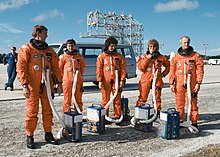Personal Egress Air Pack

Personal Egress Air Packs ( English for personal exit air packs , abbreviation PEAPs ) were used on board the US space shuttles . They should provide the astronauts with breathable air for about six minutes in the event of a fault on the ground. This was not guaranteed by a compressed air supply, rather the devices were supposed to filter the cabin air.
The PEAPs came into the limelight after the space shuttle Challenger crashed . After the Challenger's crew part was found, it was discovered that three of the six PEAPs were activated, those of Mission Specialist Ellison Onizuka , Mission Specialist Judith Resnik and pilot Michael Smith . Based on the location of the switch on Smith's device, it was suspected that his PEAP was turned on by Resnik or Onizuka. The conclusion was that at least two crew members had survived the separation of the cockpit from the rest of the ferry. In the event of a pressure loss in the cabin, however, the PEAPs would not have been sufficient to supply the crew with sufficient air during the two-minute crash.
The Personal Egress Air Packs became superfluous with the introduction of the Launch-Entry Suits , which in turn were replaced by the Advanced Crew Escape Suit .
Individual evidence
- ↑ Joseph P. Kerwin: Letter from Joseph Kerwin to Richard Truly relating to the deaths of the astronauts in the Challenger accident. NASA, accessed November 1, 2013 .